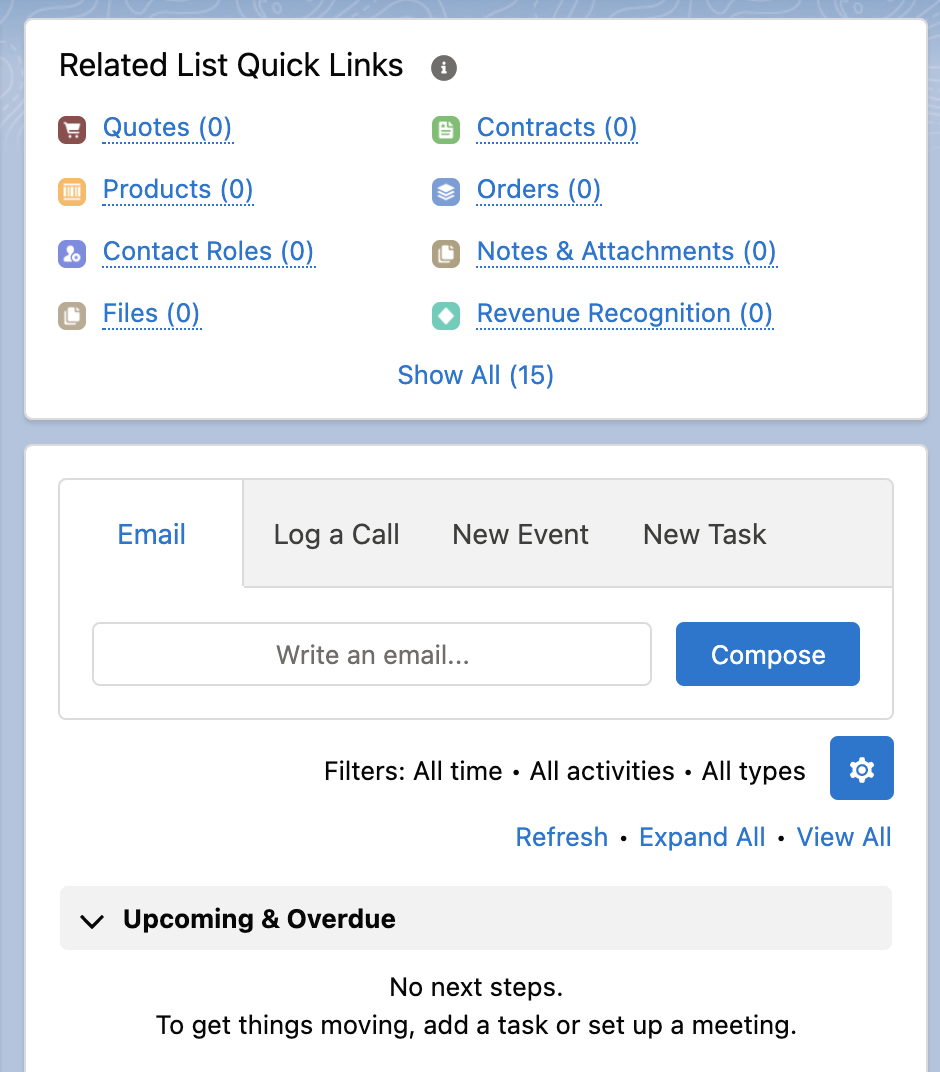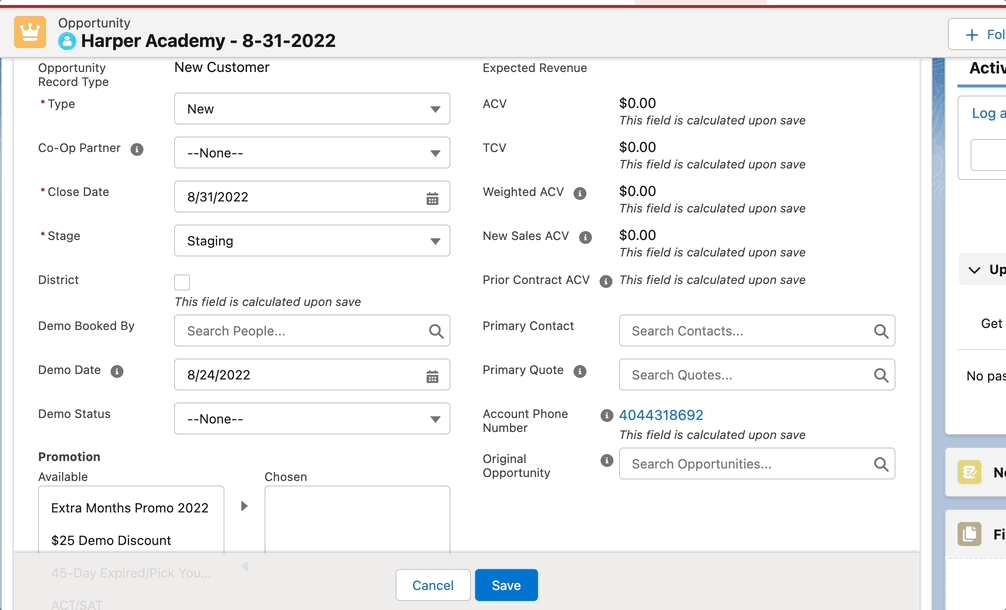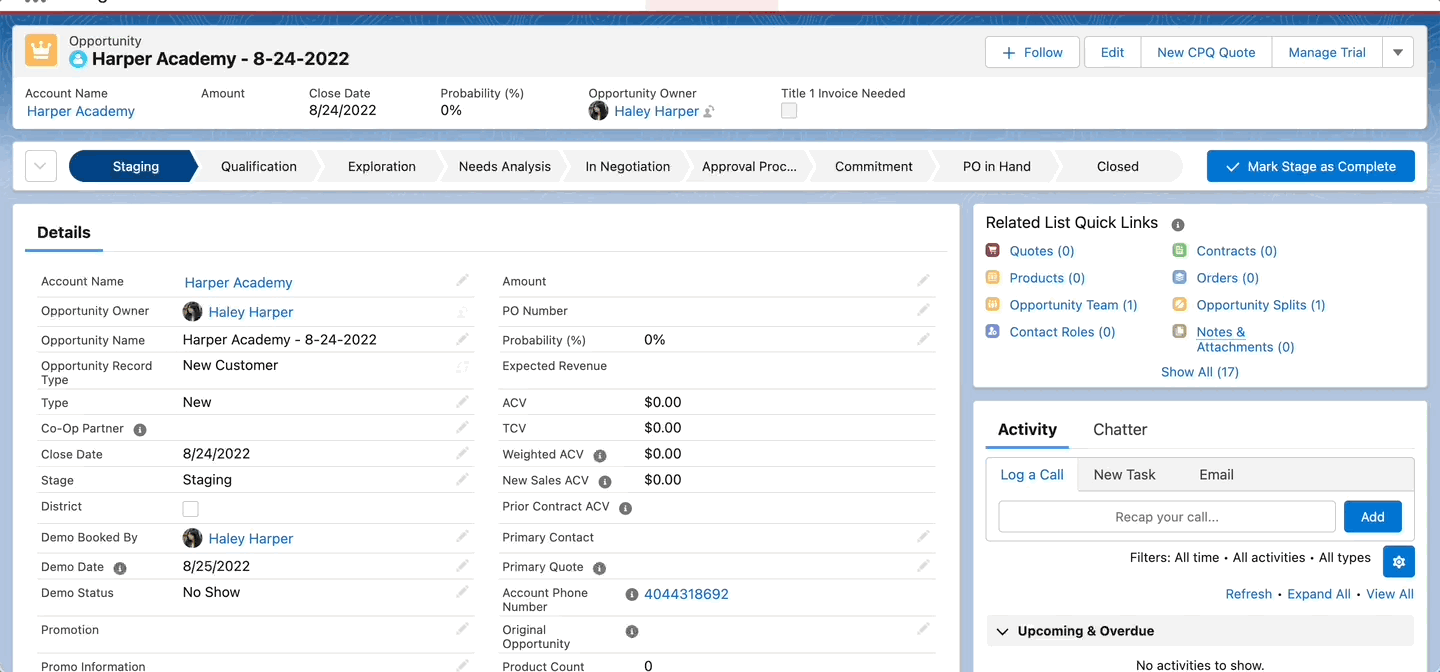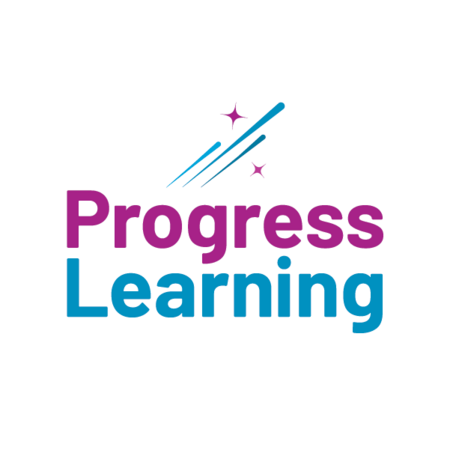Academics
Academics Style Guide
Centering a Chart/Table in the Question Stem
Creating Multiple-Choice Questions
Creating a New Product in ACE
GA Math - How to Find the new GA math standards
How to Create an Article in HelpDocs for Academics
Learnosity JSON Templates
Point Values and Scoring Logic for Item Types
Requirements for Activating Subjects
Uploading Videos to PL
Video Template Links
Account Executives
AE Opportunity Management
AE Quote Approval Process
Activating Prospect Trials - Account Executives
How Do I Clone a Quote?
How Do I Configure An Extra Free Months Promotion Quote?
How Do I Convert or Disqualify Leads?
How Do I Create Opportunity and Quote Records?
How Do I Create a District Quote?
How Do I Create a Lead Record?
How Do I Create a Multi-Year Proposal?
How Do I Edit an Existing Quote?
How Do I Prospect Using Quick Call? (Account Executives)
How Do I Work Inbound Leads?
How To Create Activity Records Associated With Opportunities
How to Schedule Demos and Events in Salesforce?
How to Work BDR Created Opportunities (Account Executives)
New Sales Quote Manager Approval Process
Pipeline Migration
Salesforce/Hubspot - AE Standard Operating Procedures
K-5 Demo Script
BDR- Business Development Representatives
How Do I Create an Opportunity Record? (BDRS)
How to Prospect Using Quick Call (BDRs)
Installation Steps to Complete for Mockingbird
Mockingbird App Training Video (Quick Call)
CRM
Customer Support
Chatbot Components
Horizon Education - Support Introduction
How Do I Classify Bug Support Cases in Salesforce?
How Do I Complete a Clever/Classlink integration?
How Do I Create a Case in Salesforce (phone call)?
How Do I Work Integration Cases in Salesforce?
How do I create a Customer Support Command Article?
Progress Learning Helpdocs Style Guide - Support
Horizon Education
IT Support & Systems
A.I. Artificial Intelligence
Calendly
Google Calendar
Google Workspace
Hardware
How to Add the Plano Office Printer to Your Progress Learning MacBook
Progress Learning Update Process (macOS)
IT Processes
Paycor
Getting Started With Objectives and Key Results (OKRs)
How Do I Complete Performance Reviews? (Employee)
How Do I Create Departmental/Individual Objectives in Paycor?
How Do I Submit Time Off?
How Do I Update My Photo in Paycor?
Paycor - 1:1s
Performance Insights - Objectives (DRAFT)
Performance Review (Managers)
Vonage
Zoom
How Do I Connect my Calendar with Zoom?
How Do I Reserve a Room at the Plano Office?
How Do I Share My Screen to the Mothership TV?
Zoom Best Practices
Zoom Cloud Recording Policy
Zoom Scheduling Privilege: How to Manage Meetings for Other Users
Booking Meeting & Phone Booth Space in Plano
DNS Adjustments (For Travel Use Only)
Everything You Need to Know about Slack
How Do I Submit Credit Card Expenses in Nexonia?
How Do I Submit a Salesforce IT Helpdesk Ticket?
How Do I Update My Photo in Google?
How do I use Bucketlist?
How to Create a New Article in Help Docs
How to Fix Wi-Fi Issues on Your MacBook While Traveling or Flying
Opensense Signatures for Progress Learning
Progress Learning Employee Group Management
Progress Learning Migration Steps
Setting up Salesforce Multi-Factor Authenticator
Using Ramp - Finance
Using Zywave
macOS Tahoe 26 Guide
Integration Processes
Enabling Notifications for Clever Status Updates
How to set up a Canvas Integration
How to set up a school with NWEA MAP
NWEA Mapping Page - Details & Troubleshooting Steps
Internal Training
AE Training Practice
BDR Training Practice - How to Create Opportunities
Contact Management
Onboarding Specialist Hands-on-Learning
Trial Procedures
Marketing
New Sales
Account Executive Quick Start Guide
How Do I Manage Contacts within Salesforce?
Request for Proposal (RFP)
Onboarding
How Do I Assign Onboarding Cases (Manager)?
How Do I Work Onboarding Cases?
How to Managing Event Settings in Google Calendar
Order Processing
Customer Invoice request (via Slack & Salesforce)
DPO- Delayed Payment Option Process
How Do I Take a Payment?
Order Processing Coordinator - Queueing Opportunities
Processing Orders - Getting Started
Tax Exemption Cases
What if I Receive a Task from Processing Regarding an Error?
Platform Training
How Do I Create an Employee Login for Progress Learning?
How Do I Input Data into Demo Accounts Quickly?
How Do I Use Our CRM?
Platform Training and Knowledge Check
Progress Learning - Platform Practice
Progress Learning Webinars
Student Experience Training - Internal
Product
Jira Bug Ticket Creation
Product Feedback
Product Roadmap
Progress Learning Updates
Release Highlight Videos
Renewals
CPQ - Quoting
How Do I Create a New Opportunity and Link it to an Existing Contract in Salesforce?
How to Add Upsell Products to a Renewal Quote
How to Create a Basic Renewal Opportunity and Quote
CPQ Amendments
CPQ Amendments- Full Return
CPQ Amendments- Partial Return
CPQ Amendments- Product Swaps
CPQ Amendments- Upsell / Add On
Sales Engagement and Work Queue
Trials
How to add a new contact record in Salesforce and add a relationship
Sales Collateral
Sales Training
Salesforce
CPQ
Salesforce Basics
SF Accounts
About Progress Learning Account Health Scorecards in Salesforce
Account Page Layout Changes (March '24)
How Do I Create a New Account Record?
How Do I Merge Accounts in Salesforce?
Manual Syncing Account Information Updates
Trial Upgrades
Updating Parent Accounts / Districts in Progress Learning
Updating Subscriptions / Contracts
Where Do I Find Progress Learning Account IDs in Salesforce?
SF Contacts
Atlas Permissions
Create and Customize List Views in Salesforce
How Do I Log Activities in Salesforce?
How Do I Manage Bad Leads in Quick Call?
How to Log a Call in Salesforce
How to send a list email in Salesforce
Navigating the Home Screen in Salesforce
Opportunity Page Layout Changes (June '24)
Salesforce Glossary
Salesforce List Views Overview
Searching in Salesforce
Send a Text Shortcut(Snippet)
Sending a Template
Update Time Zone in Salesforce
What are Salesforce Objects and Records?
Salesforce Release Notes
Sales Ops Release Notes: April '24 (I20)
Sales Ops Release Notes: Feb '24 (Georgia)
Sales Ops Release Notes: Jan 1, 2024
Sales Ops Release Notes: Jan 30, 2024 - Five Points
Sales Ops Release Notes: Mar '24 (Howell Mill)
Sales Ops Salesforce Release Notes Index
Salesforce Sales Engagement
Add a Contact to a Cadence
Check Info on a Contact within Inbox
Complete a Phone Step
Complete an Email Step
Connect Salesforce to Gmail
Connect Zoom to Salesforce
How Do I Create and Work Tasks in Salesforce?
Inbox Setup
Remove a Contact from a Cadence
Send a Meeting Time
Conga Sign Process
Messaging Configuration
PL Messaging Testing
Salesforce to Progress Learning Sync FAQS
Using the New Field Glossary Tool in Salesforce
Success (CSM)
Training Team
2025 Training Products
Helpdocs Request Form
How to Efficiently Build Data in Progress Learning
Links to Recorded Trainings and Links to Register for Live Training Webinars
Live Training Calendar
Monthly Webinar Topics (Webinar Blurbs)
New Trainers: Platform Practice
Presenter Post-Training Feedback Form
Progress Learning Helpdocs Style Guide
Training Brochure: Updated Fall 2025
Training Request Form
Table of Contents
- All Categories
- Account Executives
- AE Opportunity Management
AE Opportunity Management
The purpose of this article is to document the process used by an AE to manage the opportunity lifecycle.
- AE's will create an opportunity once a prospect has engaged in a sales process or a demo has been scheduled. The opportunity is created by creating a quote in the quote generator. For more information on creating an opportunity, please see this article. In creating the quote, ensure that you select one of the following opportunity types:
- New - net new customer opportunity
- Add-on - opportunity to sell additional content to a customer in the first 90 days
- Win back - opportunity to win back an expired account
After creating the opportunity, fill in the “New Sales Lead Source”.

- Even if a school does not belong to a district, a district/parent account must be related to a parent account before syncing to progress learning as this will prevent issues in the future. For example: A charter school that is not related to a district, still must have a district account created and related. To view how to create the district record, click here.
Quick Links and Activities
- On the right-hand panel, you will find a section for Quick Links. These links will provide you detail for quotes, products on the opportunity, and contacts
- Also on the right hand panel you will find the activities pane that provides a summary of all interactions and notes related to the opportunity. A user can also record new activities in this panel.

Opportunity Progression
- As the opportunity progresses through the sales process, update the stage. Click on the new stage. Click “Mark as Current Stage”.

To determine the correct stage, follow the below definitions:
Stage Name | Weighting | Prospect Interactions |
Staging | 0% |
|
Qualification | 2% |
|
Exploration | 10% |
|
Needs Analysis | 25% |
|
In Negotiation | 50% |
|
Approval Process | 75% |
|
Commitment | 90% |
|
PO in Hand | 99% |
|
Closed Won | 100% |
|
Capturing Competitor Information
All New sales team members are required to actively seek out information related to competitors or alternate solutions that an Account may be considering. We’ve set up a series of easy-to-use Competitor fields for you to capture this information.
When we first begin a direct conversation with the decision-maker at the Account (New sales) or when we first engage the decision-maker during the Renewals process, we want to explicitly ask if they’re using a competitor or considering any other similar resources. We have five pieces of information related to competitors that the Opportunity Owner should populate for each of her/his opportunities, based on this conversation with the Account:

- Competitor Status - "Currently Using" and "Formerly Used" are straightforward. "Switching To" is there to indicate when an account chooses to leave us or to go to a competitor, so that we have context around Closed-Lost opportunities.
- Competitors Used - you’ll find "Other" at the bottom of the scrolling list (not shown) so that you can enter a competitor name that may not be available in the drop-down.
- Current Competitors - indicate here if you know that the Account responsible for this Opportunity is evaluating us against a named competitor. If they decline to share the name of the Competitor, mark this as “None.”
- Competitor Details - this is an optional free text field for you to add color commentary. You might add here a comment the account makes about the competition, a feature they say they don’t like in a competitor’s tool, a feature they’ve indicated would say their decision, etc.
Renewal + New Rooftop Splits
There are instances where a new sales Account Executive may be working an opportunity record that has both existing rooftops and new rooftops. In this case, the Opportunity Type of Renewal + New Rooftop should be selected on the opportunity. This is the case even if the existing rooftop is an upsell or a renewal.

Opportunity records with the Renewal + New Rooftop type selected will appear on the New Sales pipeline report.
Salesforce does not currently support tracking of splitting opportunity revenue credit between new sales and renewals. Those splits will need to be tracked manually.
How to Reschedule a Demo
- In Salesforce, Open the opportunity record.
- Check the pencil next to the Demo Status Field and select Reschedule.
- Check the pencil next to the Demo Date Field and select the new Demo Date.
- Check the pencil next to the Close Date Field and update the Close Date to three months after the rescheduled demo date. Click Save.

How to Change the Opportunity Stage to Closed Lost
- Open up the opportunity record.
- Click the pencil in the Demo Status field. Select no show or cancelled.
- Click the pencil in the Stage field. Select Closed Lost. Click Save.

